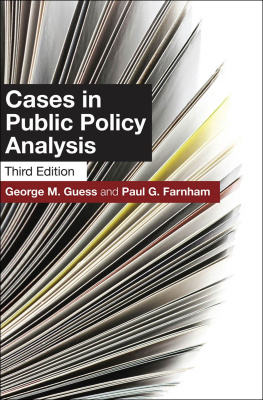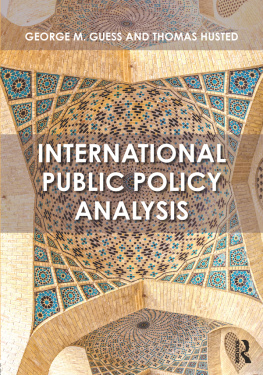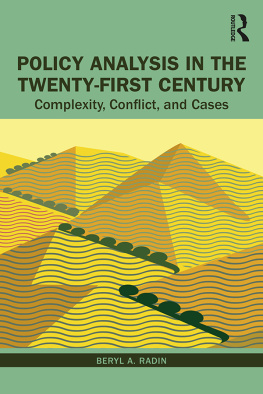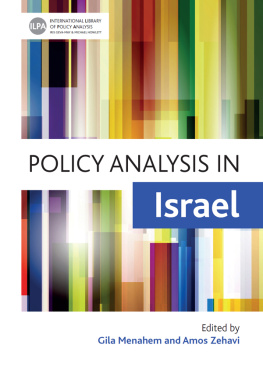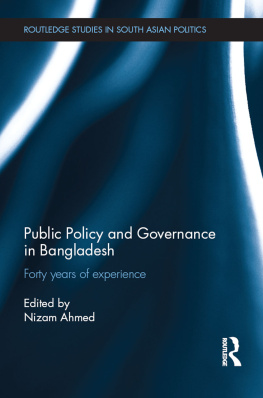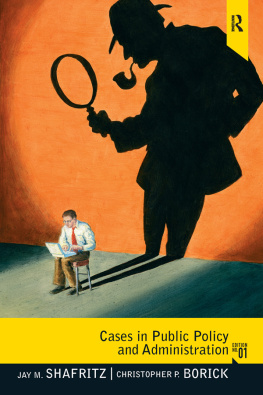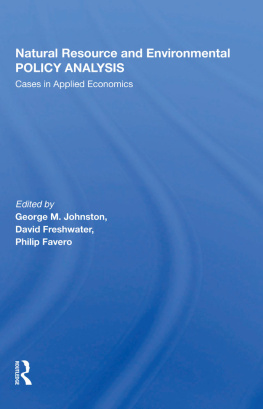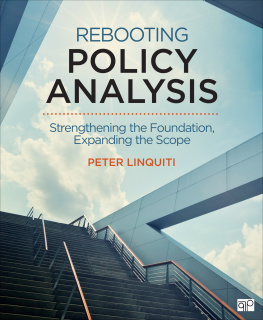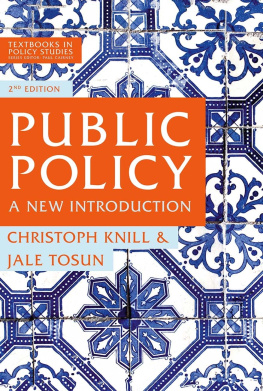Georgetown University Press, Washington, D.C.
www.press.georgetown.edu
2011 by Georgetown University Press. All rights reserved. No part of this book may be reproduced or utilized in any form or by any means, electronic or mechanical, including photocopying and recording, or by any information storage and retrieval system, without permission in writing from the publisher.
Library of Congress Cataloging-in-Publication Data
Guess, George M.
Cases in public policy analysis / George M. Guess and Paul G. Farnham. 3rd ed.
p. cm.
Includes bibliographical references and index.
ISBN 978-1-58901-734-4 (pbk. : alk. paper)
1. Policy sciencesCase studies. I. Farnham, Paul G. II. Title.
H97.G84 2011
361.61dc22
2010037043

This book is printed on acid-free paper meeting the requirements of the American
National Standard for Permanence in Paper for Printed Library Materials.
15 14 13 12 11 9 8 7 6 5 4 3 2 First printing
Printed in the United States of America
Preface
There are four distinguishing features of the third edition of Cases in Public Policy Analysis that may influence its adoption for upper-level or graduate public policy courses. First, because it was written by a political scientist and an economist, both of whom have consulted extensively and worked in various government agencies, the text takes a political economy approach to public policy. This provides an important institutional and political dimension in applying economic methods to policy problems. Second, the text focuses only on the problems and tools applicable generally to the policy analysis process and specifically to decision optimization rather than the entire policymaking cycle. As is known, generic policy processes include policy development, approval, implementation, and evaluation. Third, the book emphasizes that any technical decision tool includes political values. For transparent policy-making, these values must be recognized, weighed, and scored properly.
As William Dunn has noted, researchers and practitioners in the public policy field are still grappling with the issue of how to maximize technocratic guidance without ignoring the values and decision styles that are inherent in policy implementation (Dunn 2008). Many recognize that the field needs analytic methods to ensure balance. However, excessive faith in technocratic policymaking is nave, whereas excessive emphasis on values and decision styles may result in arbitrary decision making. Policy analysts should provide useful information for decisions, including the results of formal quantitative analyses in order to develop realistic policy options. However, analysts must be aware that decision makers will consider these results in the context of the values of the relevantand often the most powerfulstakeholders in the policy process.
Fourth, the book uses cases rather than a text/problem approach. We use the case method to educate and train future decision makers for three reasons. First, students will typically achieve and retain a more thorough knowledge through cases than through the text method. Other policy analysis texts share this view. For example, it is clear to those of us who have tested the case method against the exercise method that students gain more understanding of complex decision processes when they apply their knowledge to analyzing and deriving solutions for cases than when they read and memorize text materials (Anthony and Young 1994, 1415).
Second, cases give students insights into real-world complexity. Textbooks often use hypothetical examples or provide incomplete analyses of messy, complex problems. By contrast, policy cases provide intellectual tools to aid practitioners in the identification and specification of policy problems and the development of sensible, useful, and politically viable solutions (deLeon and Steelman 2001, cited in Morse and Struyk 2006, xi). Ultimately, the purpose of using cases is to move students and practitioners from the descriptive to the critical or analytical level of thinking (Morse and Struyk 2006, xii). In the former Soviet Union and in central and eastern Europe, university public policy departments now employ cases as a reaction to the excessively theoretical emphasis of prior pedagogical systems. It is believed that the case approach best prepares professionals with the conceptual and analytical skills for analysis of sectoral and cross-disciplinary public policy issues (Staronova 2007, 6). On the perceived basis of a practical skills gap in public and nonprofit organizations in these regions, the Open Society Institutes Local Government Initiative (LGI) provided grants to universities, nonprofit organizations, and think tanks to develop innovative cases and teaching methods (LGI 2006). The cases are available for classroom use at http://lgi.osi.hu/.
Third, cases show students how important it is to be able to clearly communicate the results of technical analyses. Many policy failures can be traced to technicians inability to simplify the bases for decision making and communicate the options to the public. For this reason, cases and materials have been developed to improve the writing of policy papers and communication tools used by the public policy community in the policymaking process (Young and Quinn 2002, 1). Cases can demonstrate how decisions are often made under extreme time constraints and with limited or incomplete information.
Some may argue that cases are ambiguous and frustrating because the reader cannot simply apply formal scientific methods to them. However, most nontrivial policy problems cannot be solved solely by applying scientific principles and quantitative techniques. Values are important, data are often incomplete and ambiguous, and time is usually short for obtaining results. Real-world decision makers must work under these constraints or be held accountable for not making decisions under pressure.
The book does not use a case approach exclusively, however. It includes background text material and basic presentations of analytic techniques useful for sorting out relevant facts and reaching conclusions on each issue. It is hoped that this combination of case information and text materials will enable students to learn more about how to apply standard public policy procedures, such as problem definition and cost-benefit analysis, to real policy issues.
To summarize this preface, cases can achieve multiple objectives. Staronova (2007, 1112) suggests that cases can be used for discussion roles, debate and panel competition, simulation and role-playing, group work, individual research, data gathering and analysis, and presentation and practical skills. These are obviously important results. To attain them, however, instructors need to glean as much as they can from the cases without overwhelming the students. Using as an example a well-known case such as the

 This book is printed on acid-free paper meeting the requirements of the American
This book is printed on acid-free paper meeting the requirements of the American
